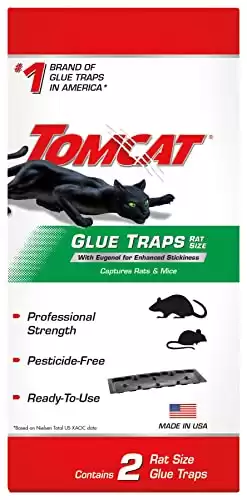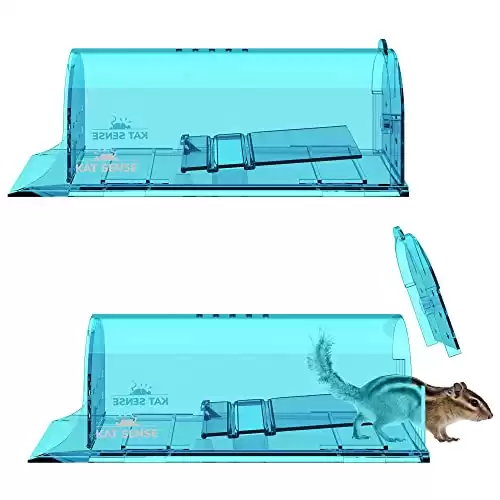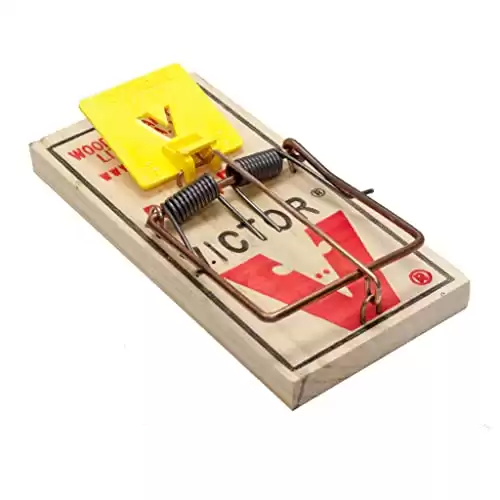| Best for | Product |
|---|---|
| Best Value | Natural Armor Peppermint Repellent for Mice and Rats |
| Best Glue Trap | Tomcat Glue Rat Traps Rat with Eugenol |
| Best Live Traps | Large Humane Rat Traps, Set of 2 |
| Best Snap Trap | Victor 12 Easy Set Rat Snap Trap |
| Best Bait Box | Outpost Rat Bait Station |
| Best Electronic Trap | TRJETIFE Electric Rat Trap |
| GSM Brands Twist Ties: 328 Feet Plastic Coated Wirewith Convenient, Built-in Cutter |
Although there are native rats and rodents on every continent, diverse species have spread due to commerce and migration and have evolved to suit various environments. When rats remain in the wild, that’s all well and good, but when they become overly accustomed to your house and yard, there may be major repercussions.
Rats are challenging and deadly pests in the house for the same reasons that have made them so effective in spreading around the world. They have developed resistance to the illnesses and parasites that they may carry into your home and surrounding environment.
Some species of rats have an obsession with bright, metallic objects, which may prompt them to chew apart vehicle engines and destroy them to the tune of thousands of dollars. Let’s discuss ways to rid your older home of rats.
 Check Amazon
Check Amazon- Captures rats, mice, other rodents, and insects
- Features Eugenol for enhanced stickiness
- Helps eliminate rat problems
- Easy to use
- Can be placed in small spaces and pathways that rats frequent
 Check Amazon
Check Amazon- Cruelty-free
- Captures rats without killing them so you can release them away from your home
- Child and pet friendly, with no bait blocks or snaps to damage fingers, paws, or noses
- Recommended by animal rights organizations such as PETA
- Available in sizes for rats and for mice
 Check Amazon
Check Amazon- Can be used in residential, commercial, or industrial buildings
- Place along walls, near baseboards, and along other pathways frequented by rats
- Pet-safe, but should be placed where children and pets cannot tamper with them
- Constructed from wood, wire, and plastic
- Can be baited with anything, but peanut butter is an effective bait due to its stickiness and "rat appeal"
 Check Amazon
Check Amazon- Secure, compact, high-quality, lockable, and tamper-resistant
- Can be installed vertically or horizontally
- Eliminates mice and rats
- Place along walls and other rodent pathways
- Made in the U.S.A.
 Check Chewy
Check Chewy- Releases 6,000 - 9,000 volts of electricity for up to 4 minutes to kill rats instantly without pain
- Features an anti-escape door
- Also allows users to capture rodents unharmed for release
- A safety switch prevents pets from being electrocuted
- Designed so you can dispose of rodents without seeing or touching them
Rats Carry Diseases
Chewed-up furniture, cords, and family heirlooms aren’t the only destruction rats can bring into your home; they also carry diseases. Over 35 illnesses are carried by rodents globally. Direct contact with rats, exposure to rodent excrement, urine, saliva, or rodent bites are all ways that these illnesses can be transferred from rats to people.
Rat-borne illnesses can also be transmitted to people by ticks, fleas, or mites that have eaten an affected rodent. Some of the most common deadly diseases rats can transfer to humans are the following:
- Salmonella
- Rat-bite fever
- Plague (Yes, you read that right!)
- Tularemia
- Hantavirus
If you’ve been bitten by a rat or had any contact with rat excrement (including through inhalation), please be mindful and visit a doctor immediately if you start to experience any signs of sickness.
Signs of Rats in Your Home
Luckily, rats often make their presence known, making it easy for homeowners to know when there’s an issue. Here are some of the telltale signs that you could have rats in your house!
Rat Droppings
As they go through your house, rats deposit droppings around. Along the major rat paths, you could see small, black pellet-shaped droppings. Rats build and maintain known pathways around the walls because they have poor vision. They also leave oil marks and smudges on the walls as they go along these pathways.
Damage to Property
Rats will also cause damage to their environment. They could consume food left out on the counter, chew through electrical wires, and nibble on furniture, storage bins, or paper. As they move about, they may leave poop and pee throughout your house, increasing your chance of contracting illnesses.
Stinky Smells and Strange Noises
Rats emit a powerful ammonia odor. They travel throughout your house generating loud noises like squeaking, clawing, and shuffling. Any of these indicators should be observed to confirm the presence of rats in the structure.
How to Get Rid of Rats
There are things you can do to figure out if you have rats in your home. In addition, if you happen to find these annoying little critters, we’ve included a detailed list of the types of rat traps and the best ones on the market. Here’s what you should do if you think you have rats in your old home.
Perform a House Inspection
A thorough house assessment is required to determine the source of the rats before you can eliminate them. Look for visible entry points on the outside of the house, paying particular attention to faulty drains, gaps in your garage door, openings around vents, and crevices in the foundation.
Examine the ducts, pipes, and appliance lines, as well as other potential entry spots within the home. You may plug the entry sites and place traps once you’ve identified where the rodents are entering the house.
Close Any Entry Points
Rats may enter your home through small openings. They can actually fit through any opening that you can get two fingers into. Seal any cracks in your interior or external walls keeping this in mind. Plug these spaces with wire wool, aluminum kick plates, concrete, or caulk for long-lasting solutions. Make sure they are well-maintained by inspecting them a few times each month.
Keep a Clean Home
Rats adore hiding places and refuge. Eliminating rats’ hiding spots is one of the finest non-poison methods for getting rid of them. Get rid of the junk in and around your house, and take everything away from the walls. Also, be sure not to leave food out and clean up any crumbs or dirty dishes.
Call an Exterminator
If you don’t have to use traps or do the job yourself, there are plenty of exterminators that will do it for you! Use a local, reputable pest control service to assist you to get rid of them. They will assist in identifying the sites of entrance for rats, find where they nest and store food, and remove them from your walls without causing more harm to your house. Additionally, experts can assist you in determining the source of the infestation and preventing future rat infestations.
- This long-lasting formula comes in a gallon spray bottle
- Ready to use with no mixing required
- Can be used inside and out
- Will not leave a stain
- 100% money back guarantee
Types of Rat Traps
By far the easiest way to get rid of pesky rodents is by setting a trap. There are several types of rat traps available to help with everything from a single rodent to an entire infestation. Check out some of our favorites below!
Glue Traps
One of the most efficient and contentious methods of trapping rats is the use of glue traps. A very sticky glue is applied to one side of a flat plastic panel to create a glue trap. You set up the board in a rat-infested location. The rat is immobilized when it scrambles across the board and gets trapped in the glue. It grows more and more entrapped as it resists.
Since most people think that these kinds of traps are inhumane, it is not advised to use them. The animal slowly dies from malnutrition or dehydration if the trap does not kill it. Additionally, glue traps gather dirt, dust, and sometimes insects, which finally renders them useless. They cannot be used again either.
- Captures rats, mice, other rodents, and insects
- Features Eugenol for enhanced stickiness
- Helps eliminate rat problems
- Easy to use
- Can be placed in small spaces and pathways that rats frequent
Live Traps
By catching the rats alive in these traps, you may humanely move them. When it comes to not killing rats, this is the most compassionate strategy. Rats should ideally be released 200–300 feet away from your home. If you have kids or dogs around the house, this is the ideal option.
- Cruelty-free
- Captures rats without killing them so you can release them away from your home
- Child and pet friendly, with no bait blocks or snaps to damage fingers, paws, or noses
- Recommended by animal rights organizations such as PETA
- Available in sizes for rats and for mice
Snap Traps
This is the standard rat trap, which is made out of a tiny piece of wood and a strong metal wire. You may set the trap using a spring and catch. On a tiny piece of metal that is connected to the catch, some bait is put on it. Following the rat’s consumption of the bait, the capture is released, resulting in the metal component of the catch snapping shut on the rat’s head, breaking its neck, and instantly killing it.
These traps are inexpensive and practical, but they also carry a risk of harm. In households with young children, snap traps should not be used since, based on the scale of the trap, they might injure or even shatter fingers.
Another alternative involves plastic snaps. This kind of trap employs a device that resembles a snake’s open mouth. These plastic jaws clamp shut when a rat enters them and consumes the bait, putting pressure on it and causing it to suffocate.
This kind of trap is ideal for houses with kids since, unlike a regular wire mousetrap, it doesn’t close with enough power to hurt fingers or toes. Although these traps are reusable, they are more expensive than regular snap traps.
- Can be used in residential, commercial, or industrial buildings
- Place along walls, near baseboards, and along other pathways frequented by rats
- Pet-safe, but should be placed where children and pets cannot tamper with them
- Constructed from wood, wire, and plastic
- Can be baited with anything, but peanut butter is an effective bait due to its stickiness and "rat appeal"
Bait Boxes
Rats can be poisoned and lured in with the use of bait boxes. These traps entice mice in with a tasty fragrance, but they quickly perish from internal bleeding or from kidney, liver, or heart failure after being devoured (depending on the poison).
Another negative is that since rats frequently perish in inaccessible locations, you will have to deal with the foul stench that will only become worse as time goes on until the body is properly disposed of. You should probably utilize rat bait boxes outdoors as a result.
- Secure, compact, high-quality, lockable, and tamper-resistant
- Can be installed vertically or horizontally
- Eliminates mice and rats
- Place along walls and other rodent pathways
- Made in the U.S.A.
Electronic Traps
A high-voltage shock is used in this fatal rat trap variant because it is more merciful. The baited region along the rear wall of this tunnel-shaped trap draws the rat inside. A steel plate on the floor makes up the tunnel’s interior.
The plate discharges a shock of 7,000 volts as soon as it detects pressure, instantaneously killing the rat. Most electric traps utilize four C batteries, which is about equivalent to the amount of power found in many battery-operated kids’ toys. Kids or larger pets like dogs and cats won’t be harmed by the shock, which is not very strong.
- Releases 6,000 - 9,000 volts of electricity for up to 4 minutes to kill rats instantly without pain
- Features an anti-escape door
- Also allows users to capture rodents unharmed for release
- A safety switch prevents pets from being electrocuted
- Designed so you can dispose of rodents without seeing or touching them
Rat-Proof Your Yard
One of the best ways to prevent rats from taking over your home is to start by safeguarding your yard. Understanding what draws rats to the yard is essential if you want to get rid of them. There is vegetation that entices rats, so you can be luring them without even being aware of it.
You must first comprehend the rat’s environment in order to set up successful rat traps. If you want traps to function, you need to get rid of whatever is luring the rats. Rodents prefer overgrown environments over open spaces because they offer protection from predators and make an excellent location for nesting.
You should deny rats access to refuge if you want to keep them out of your yard. Maintain a well-groomed lawn and eliminate any heaps of wood, brush, waste, compost, thick shrubs, ground coverings, and ivy from your yard since they will eventually attract rats. Maintain storage shelters’ appropriate seal by repairing or covering all gaps with long-lasting materials like concrete, aluminum flashing, steel wool, or thick welded wire.
- 0.6mm iron wire
- Coated with green PE plastic
- Features a built-in cutter for convenience
- Durable, reusable, easy to bend and twist
- Can be used for gardening, home repairs, crafting, and more
Water Attracts Rats
Most rats need a steady supply of water, and they frequently congregate near these sources. Any sources that offer these rodents a water source must be eliminated, covered, or repaired. Swimming pools, dripping faucets, drainage lines, pet water bowls, and other types of standing water fall under this category.
Plants That Attract Rats
Rats will be drawn to plants that produce fruit and vegetables since they are a great source of nutrition for them. Rats and mice typically eat a variety of fruits, such as figs, apricots, oranges, avocados, and lemons. Almonds and walnuts are other favorites. As a result, it’s imperative that all fruit and nuts that have fallen to the ground be quickly collected and disposed of.
Bottom Line
There’s no denying that rats are annoying to have in your home. In addition, they can wreak havoc and cause devastating damage and bring deadly diseases too close for comfort. We hope you’re more aware of how to spot an infestation and what to do if you have one. Thanks for reading!
| Best for | Product |
|---|---|
| Best Value | Natural Armor Peppermint Repellent for Mice and Rats |
| Best Glue Trap | Tomcat Glue Rat Traps Rat with Eugenol |
| Best Live Traps | Large Humane Rat Traps, Set of 2 |
| Best Snap Trap | Victor 12 Easy Set Rat Snap Trap |
| Best Bait Box | Outpost Rat Bait Station |
| Best Electronic Trap | TRJETIFE Electric Rat Trap |
| GSM Brands Twist Ties: 328 Feet Plastic Coated Wirewith Convenient, Built-in Cutter |
Thank you for reading! Have some feedback for us? Contact the AZ Animals editorial team.






